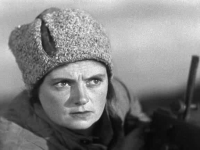
Women in Arms : from the Russian Empire to Post-Soviet States
Avant le 15 avril - PIPSS
The military has never been an male-exclusive world (soldiers’ wives, canteen women, nurses, etc.), but the fact that women could bear arms and fight, in the army or other power structures, still remains controversial, calling into question gender roles and social evolution as a whole. In 2006, the Journal of Power Institutions in Post-Soviet Societies (http://pipss.org/) dedicated one of its issue to the question of Women and/in the Military in Tsarist, Soviet and Post-Soviet Russia (http://pipss.revues.org/448). In this new PIPSS issue, we want to change the focus and tackle the question of women fighters, whether inside the army or in more or less formalized armed group.
While the specificity of the women experience as victims of war and especially sexual violence is increasingly recognized, a parallel tendency has developed among scholars to recognize that women can also be agents of violence. This body of research often draws on a gender approach to war and the military, including reflection on the notion of masculinity, with war being at the same time its ultimate manifestation and a formidable threat to it.
A basic historical overview points to several moments and contexts when women are compelled to, and socially and/or legally authorized to take arms : in radical left and revolutionary movements, where the gender role division is put into question ; during revolutionary or decolonization moments, when these social and gender roles are shattered ; in wars of resistance to an invader, total wars and wars of annihilation where armed resistance appears as the only option.
Recent publications cover several historical moments and geographical areas in a comparative perspective ; the Spanish Civil War, the First and Second World wars, Asian and Latin American guerrillas, (Alison, Bucaille, Capdevila et alii, Cardi and Pruvost, Milquet and Frederic). But these scholarly works rarely include Russia or the post-Soviet States – a context where cases and experiences of women fighters can be traced through history : Nadezhda Durova who served during the 1812 “Patriotic war” against Napoleon ; the XIXth Century social-revolutionary and terrorist movements, where women terrorists like Sofia Perovskaya climbed onto the scaffold ; the First World War, with the well-known figure of Yasha and her women regiment ; women Red Guards during the civil war ; women snipers, machine gunners, aviators, tankists or anti-aircraft crew during the “Great Patriotic War” ; women in the local conflicts of the post-Soviet era (Nagorny-Karabakh, Abkhazia, Transdnistria, Chechnya) and women suicide bombers.
Apart from historical overview on women in arms throughout Russian history (Ivanova), or during the First World and subsequent Civil War (Stockdale, Stoff, Salnikova, Shcherbinin, etc) the bulk of publications are dedicated to women during the Second World War (Conze and Fieseler, Engel, Erickson, Harris, Jug, Krylova, Markwick and Cardona, Pennington, Budnitskii, Murmantseva).
Our aim in the 17th PIPSS.ORG issue (2015) is to draw on the renewal of research on women fighters to shed new light on the question of women in arms in Imperial Russia, the Soviet Union, and post- Soviet space. While all contributions dedicated to women fighters and women in arms are welcome, we encourage submissions on the following themes :
Women and their place in the armed groups : Do women take part in combat ? What are the responses of those serving alongside them and among the military hierarchy ? How does the military manage the place of women in the armed group (practical questions such as uniform, bath, dormitories, etc.) ? What kind of relationships is established between men and women at the front and at the rear ? Sexual harassment in the armed forces and the response of military authorities.
Women’s trajectories : What are the social and personal conditions that allow for women to engage in combat ? Contemporary media discourses tends to see women as driven by personal, individual motives (eg. the “black widows” seeking revenge for their loved ones), while during the Second World War the main explanation was “patriotism”. What is the legal and social context as well as the discourses that allow women to take up arms ? What are the trajectories of women before the war, during and after the war (including the question of public policies for veterans).
Representation of women fighters : Soviet literature and cinema have given birth to unforgettable figures, such as Anka the Machine-Gunner in the film Chapaev, Marusia in Forty-first by the writer Boris Lavrenov, or the heroines of “The Dawns here are quiet” by Boris Vassiliev. Papers on representations of women fighters in literature, cinema, theatre, as well as in the press and television, are welcome.
Guidelines for submission
The journal will be published in three languages (French, English and Russian with a 100-word abstract in English), as a result of which most authors will be able to write in their native language. But we would like to draw your attention to the fact that articles in English will reach a much broader audience. The articles (30 000 to 50 000 characters) submitted topipss.org for publication should be original contributions and should not be under consideration for any other publication. Each article will be submitted to double-anonymous peer review ; final decisions on publication will be made by the Editorial Board.
If you wish to submit an article, please first contact the Chief Editor (contact@pipss.org) and send a 100-word abstract in English.
Informations : http://pipss.revues.org/169.
The deadline for article submission is end of April 2015 (extended deadline) with publication in Autumn 2015.
Contact :
Elisabeth Sieca-Kozlowski , CERSIPS c/° CERCEC, 190-198 av. de France 75244 Paris cedex 13. contact@pipss.org
Fichiers de syndication :
Statistiques :
Le site contient 4383 articles
